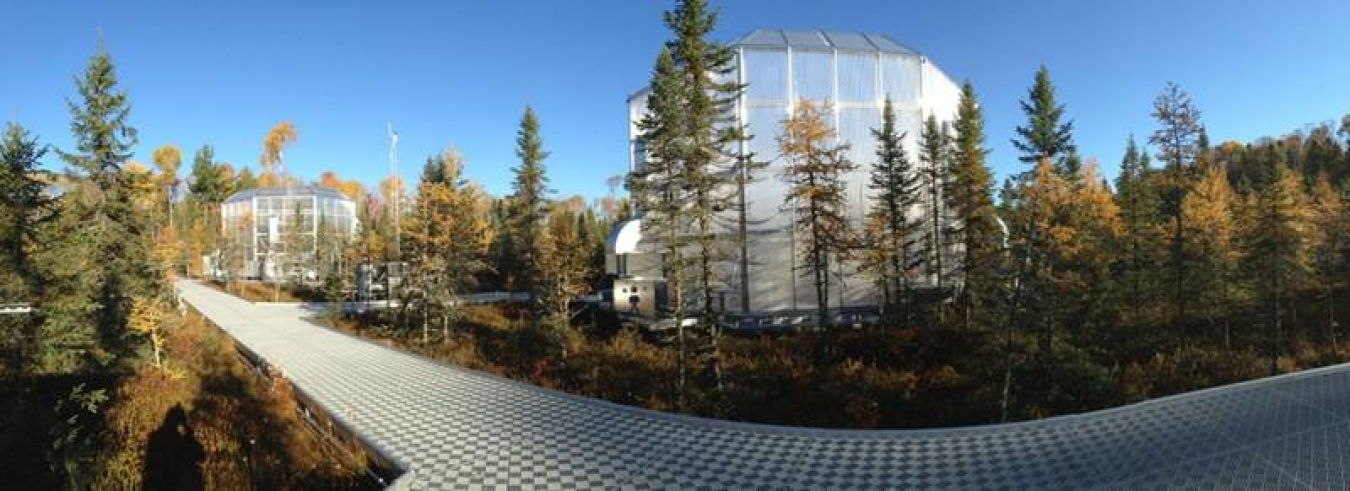The Spruce and Peatland Responses Under Changing Environments (SPRUCE) experiment provides a look into potential futures under climate change.
May 2, 2024
Evergreens create a sea of green across the northern Minnesota landscape, blanketing the land. Within that forest, octagonal greenhouse enclosures emerge from the tree line. They look slightly alien, sprouting up from the peat bog they’re on top of.
These enclosures are key tools in the Department of Energy’s Spruce and Peatland Responses Under Changing Environments (SPRUCE) experiment. SPRUCE is a field experiment that focuses on how climate change may influence peat bogs. It’s located in a black spruce Sphagnum bog forest at the southern edge of the world’s boreal peatland. Most peatland of this type is in Canada and Russia.
Peat bogs are exceptionally good at storing carbon compared to other ecosystems. Despite only occupying three percent of the Earth’s surface, they hold a third of the carbon stored in Earth’s soil. If that function is disturbed, they could have a big effect on climate change. If they continue storing carbon, they could be a valuable resource for minimizing it. But if they start releasing carbon instead, they would increase the amount of carbon dioxide in the atmosphere and accelerate climate change. Scientists think that these ecosystems may be at a tipping point. In the near future, climate change may affect peat bogs so much that they can’t return to their former function.
Scientists on the SPRUCE experiment are working to understand the effects of warming and higher atmospheric carbon dioxide on these peat bogs. They study how warmer environmental conditions affect which nutrients are available to plants, animals, fungi, and microbes. Because these raised peat bogs have limited amounts of nutrients, small shifts in their carbon and nutrient cycles could have big effects on how organisms store carbon. Ecologists and biologists use the SPRUCE manipulations to better understand changes with warming so they can improve computer simulations of Earth’s carbon cycle and climate.
The SPRUCE experiment has 10 open-topped greenhouse enclosures that allow scientists to manipulate the temperature and levels of carbon dioxide. The temperatures range from 0 degrees different from the natural environment to 9 degrees C warmer. The highest temperature reflects a maximum climate change scenario for Earth’s highest latitudes. Half of the greenhouse enclosures also have elevated carbon dioxide levels to reflect a potential future atmosphere that could benefit plant growth. Scientists are also observing several plots without greenhouses for comparison.
This field experiment allows scientists to observe changes in a natural environment that cannot be replicated at smaller scales in laboratories. The manipulated bog plots each have all of the interacting ecological and biological networks present in bogs today. The scientists are just “turning the knob” on two specific variables: temperature and atmospheric CO2.
So far, scientists have learned a great deal about these ecosystems and the potential effects of climate change.
A team with scientists from DOE’s Oak Ridge National Laboratory, Michigan State University, Michigan Technological University, Boise State University, the University of Zurich, the University of Tennessee Knoxville, and the USDA Forest Service studied if these conditions would change the nutrients available in the bog. They found that higher temperatures drastically increased the availability of ammonium and phosphate in the bog’s below-ground peat levels. These are both nutrients essential to plant growth. In the warmest experimental treatments, the heat has killed off the keystone carpet of mosses (Sphagnum) at the surface. These plants dying made even more nutrients available to the remaining organisms. In contrast, the increased amount of carbon dioxide in the atmosphere has not affected the nutrient levels at all.
In addition to directly measuring the changes of the manipulated experimental plots, the team compared their observations to predictions from a specialized computer simulation. The E3SM Land Model (ELM)-SPRUCE is designed to be part of DOE’s larger, world-class Energy Exascale Earth System (E3SM) model. ELM-SPRUCE tracks how carbon moves through the soil, with an emphasis on the role of microbes. The scientists found that the model’s initial results did not match the experimental results. Specifically, it did not predict either the amount of or timing of the increase in nutrients. This comparison shows that the scientists need to adjust the model to better reflect real-world dynamics.
Another study using SPRUCE led by scientists from Duke University looked at the role of protists. These are microbes that live within the mosses. Protists also play a major role in how carbon moves through these systems. The scientists found that the warming and the elevated carbon dioxide had different and opposite effects on the protists. The warming increased the number of protists, while the elevated carbon dioxide decreased them. The combination of the two influenced behaviors that determine protists’ carbon dioxide output. Protists aren’t currently included in climate models, so this study shows models should account for their role.
Scientists don’t have a crystal ball to know exactly how climate change or other environmental changes will affect every system on Earth. They do, however, have field experiments like SPRUCE. These field experiments, when combined with laboratory experiments and computer models, provide new insights every day. This research will help us better understand how climate change will affect ecosystems as well as inform how we can minimize those negative impacts.
Shannon Brescher Shea

Shannon Brescher Shea ([email protected]) is the social media manager and senior writer/editor in the Office of Science’s Office of Communications and Public Affairs. She writes and curates content for the Office of Science’s Twitter and LinkedIn accounts as well as contributes to the Department of Energy’s overall social media accounts. In addition, she writes and edits feature stories covering the Office of Science’s discovery research and manages the Science Public Outreach Community (SPOC). Previously, she was a communications specialist in the Vehicle Technologies Office in the Office of Energy Efficiency and Renewable Energy. She began at the Energy Department in 2008 as a Presidential Management Fellow. In her free time, she enjoys bicycling, gardening, writing, volunteering, and parenting two awesome kids.

